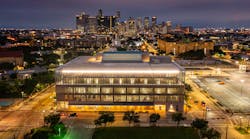Historic Retail Outlet Gets New Life as Houston's Latest Innovation Hub
In 1939, when Sears, Roebuck and Co. opened their Midtown Houston store, it was based on the brand’s modern Chicago prototype, and it was marketed as the department store of the future. Eighty years later, innovation strikes again at 4201 Main Street. A skillful adaptive reuse project led by owner/developer Rice Management Company has transformed the historic Sears building into a modern innovation hub.
The $100 million renovation project, which began in 2019 and was completed in 2021, is known as the Ion. The 266,000-square-foot facility brings together Houston’s entrepreneurial, corporate, and academic communities in a variety of collaborative spaces and programs. The Ion serves as the anchor for the surrounding 16-acre Ion Innovation District.
Rice Management Company assembled an expert team including Gilbane (general contractor); SHoP Architects (design architect); Gensler (architect of record and interior designer); Walter P Moore (engineer); I.A. Naman (MEP); James Carpenter Design Associates (design and interior light well). The former department store has been reimagined with an artful combination of Class A office and co-working space, prototyping and maker resources, event space, classrooms, food and beverage and indoor/outdoor communal areas with shared amenities.
Steeped in History
Sears’ Houston patrons were the first to enjoy an air-conditioned department store in that city. The 1938 design by Chicago-based Nimmons, Carr and Wright architects was rolled out to other Sears stores throughout the U.S. Local associate architect Alfred J. Finn also contributed to the Houston prototype, which had massive 50,000-square-foot floor plates with a central circulation around the modern escalators.
The facility boasted a top floor ballroom as well as space for Sears regional offices. Chicago-based muralist Eugene Montgomery created murals for the main sales floor interior. He did the same for stores around the country.
According to Jason Honeycutt, AIA, Senior Associate, Gensler, “The original facade featured art deco reliefs in the concrete walls with glass block and ornamental tile that vertically denoted the entries.” Outside, the building’s vitrines displayed furniture and other household wares for the modern lifestyle Sears was selling. Today, local artists are invited to show their work in brand-new street-level display windows.
In the 1960s, during a major renovation, the department store lost much of its original charm. The vitrines were filled in with brick and covered over. The granite facade was cut down and covered with metal panels.
Creating Class A Workspace
In 2018, Sears filed for bankruptcy. The property returned to Rice Management Company—aka Rice University—which had a ground lease arrangement with Sears.
“If you're familiar with Houston, the city is pretty quick to tear things down to move them out of the way for what’s next,” said Honeycutt. “However, repurposing the Sears building aligned with the client’s vision for Houston’s emerging Innovation District. From day one they understood the inherent value in the unique character of this building.” They were in favor of preserving—and to some degree, rebuilding—the 80-year-old concrete structure.
First, all those exterior additions made in the 1960s needed to be removed. “The corners of the building were largely demolished, so we had to build those back based on the original drawings,” said Honeycutt. The current envelope is a combination of preserved concrete walls and a high-performance curtain wall system assembly with shade fins and ceramic frit.
The solid exterior walls were cast in place concrete. “They were part of the original structural system, so the design preserved their structural integrity while opening the building up to daylight and views,” said Honeycutt.
“We rationalized the south end of the building for flexible floor plates, which originally served as the loading dock and customer pickup area for Sears. The building was also expanded vertically by adding two steel floors on top of the original concrete frame. Those were the initial significant challenges to make the building work for its new purpose,” said Honeycutt. “From there we had to preserve the building’s character and find ways to open it up.”
James Carpenter Design Associates created a 100-foot-wide light well that slices through the middle of the building at an angle to provide controlled daylight from a skylight above. The skylight aperture brings daylight all the way down to the lower level.
“The light well not only brings immense daylighting deep into the building, it also organizes circulation on each floor. The common corridor is wrapped around the light well on every level,” explained Honeycutt. “You’re spatially connected to every level in that way, and each level has varied amounts of space that has been programmed to facilitate connectivity and collaboration.”
Honeycutt added, “The approach to the interior design was to try and do as little as possible. The existing concrete frame and structural interventions were exposed to help define the character of the building. The original concrete and terrazzo floors were also refinished and reused throughout the building.”
At the ground floor a generous promenade and lobby create a transition zone from the restaurant and retail experience into the core of the building where visitors start to experience the light well. At the base of the light is a forum space for TED-style talks, where innovators present panel discussions and presentations.
“The dialogue is occurring right there in the heart of the building on the ground plane where the public is welcome any day of the week. Then, as you go up, there are different levels of privacy and security access on the upper floors that address the needs of the tenants.”
Streamlined Operations
The Ion team is pursuing LEED Silver and WELL certification. The entire building was upgraded with state-of-the-art, energy-efficient systems that help meet these standards. “Indoor air quality was a big focus of the new mechanical ventilation systems,” said Honeycutt. The indoor water quality also meets the LEED and WELL criteria.
The Ion is set up with an efficient central plant supplying chilled water throughout the building to each of the tenants for use in localized units. “It's not a one-size-fits-all in the tenant space,” explained Honeycutt. “Each tenant can really dial it in for their needs, and this contributes to operational efficiencies.”
Also, the client opted for straightforward building systems—because simplicity helps streamline use and operations. “We were able to design and realize the light well as a large six-story volume without classifying it as an atrium, which would have required a rated enclosure around the light well with a smoke evacuation system and emergency generator to support it,” added Honeycutt.
“Instead, we used rated horizontal shutters at two levels in the light well that compartmentalize the volume and avoid that system.” This design preserves the spatial experience within the light well and significantly reduces operational demand. From operations to design, the Ion carries on Houston’s tradition of innovation.



